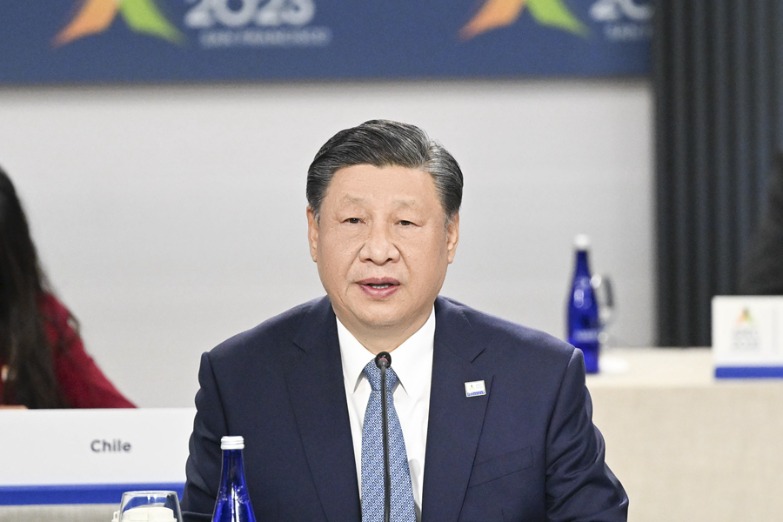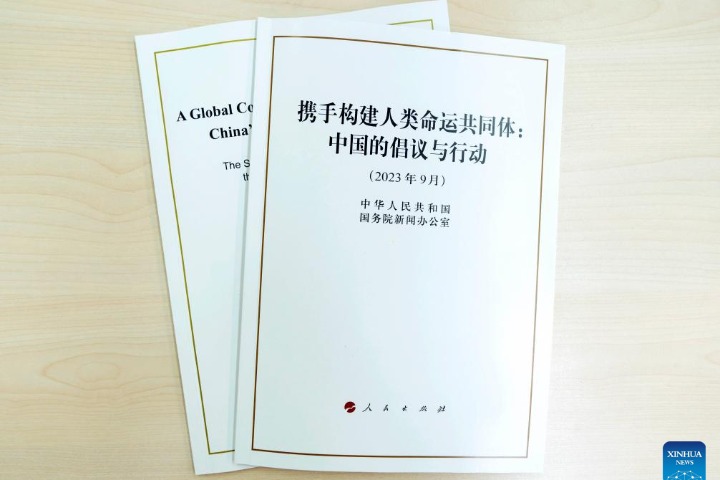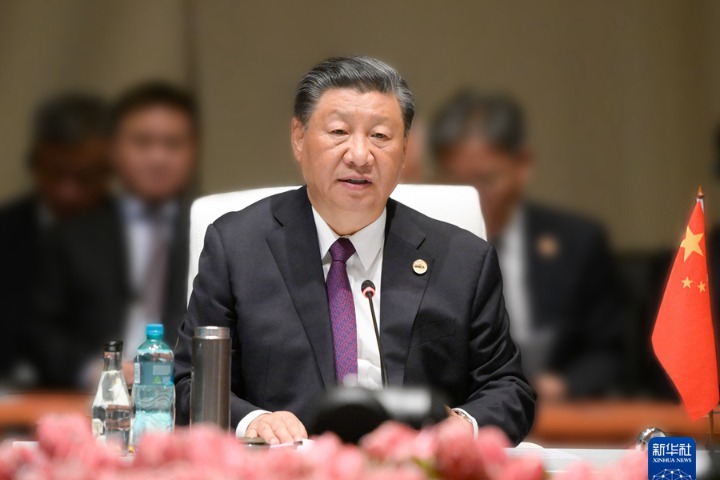《改革开放40年中国人权事业的发展进步》白皮书
新华网 2018-12-13 11:20

六、努力推动各国人权事业共同发展
VI. Facilitating the Development of Human Rights in the World
改革开放40年来,中国在大力推进自身人权事业发展的同时,积极与世界分享人权事业发展经验,为各国创造更多的发展机遇。中国秉持共商共建共享全球治理观,把为人类作出新的更大贡献作为自己的使命,倡导并推进生存权、发展权、和平权等各项人权在世界范围内的实现,努力为世界人权事业发展作出贡献。
Over the past 40 years of reform and opening up, China has redoubled its efforts to promote human rights, sharing its experience in this regard with the rest of the world, and creating more development opportunities for all countries. China follows the principle of achieving shared growth through discussion and collaboration in global governance, with a mission of making more and greater contributions to humanity. China values the rights to subsistence, development and peace and all other human rights, and strives to further this cause throughout the world.
加大发展援助。多年来,中国在减贫、教育、卫生、基础设施、农业生产等领域向亚洲、非洲等发展中国家援建的农业、工业、交通运输、能源电力、信息通讯等重大基础设施项目,帮助发展中国家满足基础设施建设需求、破除发展瓶颈,在保障当地民众民生权利实现方面发挥了重要作用。1950年至2016年,中国在自身长期发展水平和人民生活水平不高的情况下,累计对外提供援款4000多亿元人民币,实施各类援外项目5000多个,其中成套项目近3000个,举办11000多期培训班,为发展中国家在华培训各类人员26万多名。截至2017年,中国先后向亚洲、非洲、拉丁美洲和加勒比、欧洲和大洋洲的72个国家和地区累计派遣医疗队员2.5万人次,诊治患者2.8亿人次,挽救了无数生命,赢得了受援国政府和人民的高度评价。
Increasing foreign assistance. Over the years, China has provided foreign assistance to Asian and African developing countries for use in poverty reduction, education, healthcare, agriculture and infrastructure, involving major construction projects in agriculture, industry, transport, energy and power, information technology and communication, helping resolve national problems and safeguard the local peoples' life needs. From 1950 to 2016, despite its own limited development and living standards, China provided RMB400 billion of foreign aid to other countries, conducted over 5,000 foreign assistance projects-of which almost 3,000 are turn-key projects-and organized 11,000 training programs in China for more than 260,000 persons from other developing countries. By 2017 China had dispatched 25,000 medical workers to 72 countries and regions in Asia, Africa, Latin America, the Caribbean, Europe and Oceania, who have treated 280 million patients and saved countless lives, winning high praise from the governments and peoples of the recipient countries.
提升发展能力。中国国家主席习近平近年来多次在国际场合宣布一系列重大对外援助倡议和举措,充分彰显了中国促进人类共同发展的大国责任和历史担当。中国在南南合作框架下稳步扩大对其他发展中国家的援助规模,注重打造或提升区域合作平台,充分借助上海合作组织、金砖国家、中国-东盟(10+1)会议、中国东盟博览会、澜沧江-湄公河合作机制以及中非合作论坛、中拉论坛、中阿合作论坛等机制的带动作用,不断提升各国发展能力。中国提出“一带一路”倡议,发起成立亚洲基础设施投资银行和新开发银行,设立丝路基金和南南合作援助基金,设立中国国际发展知识中心,设立南南合作与发展学院,支持和帮助受援国增强自主发展能力、减少贫困、改善民生、保护环境,为各国人民发展权的实现创造更好条件。中国在吉布提、斯里兰卡科伦坡、马来西亚关丹的港口、产业、城市融合发展模式得到沿线国家的积极认同。稳步加大对外援助培训力度,通过举办培训班、派出管理人员和技术专家、派出青年志愿者、提供奖学金名额等方式,为发展中国家举办各类政府官员研修、学历学位教育、实用技术培训以及其他人员交流项目,及时分享发展经验和实用技术。2013年至2017年间,在“一带一路”沿线国家建设的经贸合作区,带动东道国就业超过20万人。“中非十大合作计划”相关项目实施后,将帮助非洲新增约3万公里的公路里程、超过900万吨/日的清洁用水处理能力,为非洲国家创造近90万个就业岗位。其中,蒙内铁路自2017年开通后,拉动肯尼亚国内生产总值增长1.5%至2%。
Improving development capacity. In recent years, President Xi Jinping has announced a raft of foreign assistance initiatives and measures, which fully demonstrate that China as a major country lives up to its responsibility for advancing the interests of humanity. Within the framework of South-South cooperation China has steadily expanded its assistance to other developing countries, with more efforts to build and improve platforms for regional cooperation, while fully relying on mechanisms such as the Shanghai Cooperation Organization (SCO), BRICS, the ASEAN Plus China (10+1) Summit, China-ASEAN Expo (CAEXPO), Lancang-Mekong Cooperation (LMC), the Forum on China-Africa Cooperation (FOCAC), China-CELAC Forum, and China-Arab States Cooperation Forum (CASCF). All are designed to improve the development capacity of the countries involved. China has proposed the Belt and Road Initiative, initiated the Asian Infrastructure Investment Bank (AIIB) and the New Development Bank (NDB) for development projects in BRICS, set up the Silk Road Fund and the Assistance Fund for South-South Cooperation, and founded the Center for International Knowledge on Development (CIKD) and the Institute of South-South Cooperation and Development (ISSCAD). All the above are aimed to encourage the recipient countries to enhance their capacity for self-development, reduce poverty, improve their people's living standards, and protect the environment. The port-industry-city integrated development model, initiated by China and adopted by Djibouti, Colombo in Sri Lanka and Kuantan in Malaysia, has been welcomed by these Belt and Road countries. China is steadily increasing foreign assistance training. By organizing training courses, dispatching management personnel, technical professionals and young volunteers, and offering scholarships, China has provided advanced study and training for government officials, higher education degree and diploma programs, and technical training and exchange programs for various kinds of personnel from other developing countries, to share development experience and technologies in a timely manner. From 2013 to 2017, by establishing economic and trade cooperation zones in the Belt and Road countries, China helped create more than 200,000 jobs in the host countries. Once the 10 major China-Africa cooperation programs are in place, they will help Africa add a total highway length of nearly 30,000 km, add clean water treatment capacity of over 9 million tons/day, and create about 900,000 jobs. The Mombasa-Nairobi Standard Gauge Railway (SGR), which opened to traffic in 2017, has helped increase Kenya's GDP by 1.5-2 percent.
开展人道救援。改革开放之初,中国的人道主义援助以支援发展中国家应对严重自然灾害为主,其中包括向遭受严重旱灾的一大批非洲国家、遭受特大风灾的孟加拉国等国提供紧急援助。2001年以来,中国逐渐加大对国际人道主义援助体系的参与度,积极参与联合国机构主导的国际人道主义援助活动,援助规模逐年扩大。自2004年以来,中国累计提供国际人道主义援助300余次,平均年增长率为29.4%。所提供援助包括向东南亚国家提供防治禽流感技术援助;就几内亚比绍蝗灾和霍乱,墨西哥甲型H1N1流感,非洲埃博拉、黄热病、鼠疫等传染病疫情,伊朗、海地、智利、厄瓜多尔、墨西哥地震,马达加斯加飓风,印度洋海啸,巴基斯坦洪灾,美国卡特里娜飓风,智利山火,加勒比有关国家飓风等提供物资、现汇和人员等人道主义援助等;向朝鲜、孟加拉国、尼泊尔等国提供粮食等人道主义物资援助。2014年3月西非多国爆发埃博拉疫情,中国向受灾地区提供四轮援助,总额达7.5亿元人民币,派出专家和医护人员累计超过1000人次。中国不断制定并完善有关国际人道主义救援法律法规和工作机制,重视加强与联合国机构和民间组织在人道主义援助领域的合作。1979年中国加入联合国儿童基金会、世界粮食计划署,恢复了在联合国难民署执委会的活动,并多次向其捐款捐物。中国红十字会、中华慈善总会、中国福利会、中国扶贫基金会等社会团体、民间组织和一些企业甚至个人都参与其中,切实向国际社会传达中国积极参与国际人道主义救援、切实维护人权的真实愿望。
Providing humanitarian relief. In the early days of reform and opening up, China's humanitarian relief focused on helping other developing countries respond to severe natural disasters. This included emergency aid to a number of African countries stricken by severe droughts and to Bangladesh hit by windstorms. After 2001, China increased its participation in international humanitarian relief, taking an active part in activities launched by UN organizations and expanding its share of aid year by year.
Since 2004, China had provided over 300 international humanitarian relief programs, with an average annual growth rate of 29.4 percent. These relief programs mainly comprise:
・ technical aid to Southeast Asian countries against avian influenza;
・ material and personnel assistance and assistance in cash
・ to Guinea-Bissau against locust plague and cholera,
・ to Mexico against A/H1N1 flu,
・ to Africa against Ebola, yellow fever, plague and other infectious diseases,
・ to Iran, Haiti, Chile, Ecuador and Mexico against earthquakes,
・ to Madagascar against hurricanes,
・ to Indian Ocean countries against tsunami,
・ to Pakistan against floods,
・ to the US against Hurricane Katrina,
・ to Chile against mountain fires,
・ to the Caribbean countries against hurricanes;
・ food and goods assistance to the DPRK, Bangladesh and Nepal.
In March 2014 when Ebola broke out in many West African countries, China provided four rounds of humanitarian relief, with a total value of RMB750 million, and deployed more than 1,000 experts and medical workers.
China has enacted laws and regulations on international humanitarian relief and improving its related working mechanisms, and forged stronger cooperation on humanitarian relief with UN organizations and NGOs. In 1979, China joined the United Nations International Children's Emergency Fund (UNICEF) and World Food Program (WFP), resumed its activities in the Executive Committee of the United Nations High Commissioner for Refugees (UNHCR) and made many donations to the UNHCR. The Red Cross Society of China (RCSC), China Charity Federation (CCF), China Welfare Institute (CWI), China Foundation for Poverty Alleviation (CFPA) and private charities, along with legal persons of certain enterprises and societies in China, have all engaged in international humanitarian relief, demonstrating to the international community China's sincere desire to engage in international humanitarian relief and to protect human rights through tangible actions.
维护世界和平。中国始终致力于与各国共同维护国际和平,支持国际和地区反恐合作,为世界人权事业发展营造和平和谐的环境,以和平促进发展,以发展巩固和平,为和平权的实现作出了重要贡献。近年来,中国努力为解决地区热点问题提供方案,在巴勒斯坦问题上多次提出主张和倡议,深度参与伊朗核问题谈判,积极斡旋南苏丹国内和解,努力推动叙利亚问题政治解决,推动阿富汗政府与塔利班开启和谈,推动朝鲜半岛问题政治解决进程。中国坚定支持并积极参与联合国维和行动。1990年4月,中国首次向联合国停战监督组织派遣5名军事观察员,这标志着中国开始正式参与联合国维和行动。截至2018年5月,中国累计向苏丹、黎巴嫩、柬埔寨、利比里亚等国家和地区派出维和军事人员3.7万余人次,先后派出维和警察2700余人次,参加了约30项联合国维和行动,是联合国安理会常任理事国中派出维和人员最多的国家,是联合国维和行动第二大出资国。2017年9月,中国完成8000人规模维和待命部队在联合国的注册工作。这是中国履行大国责任,以实际行动兑现支持联合国维和行动承诺的重要举措,也是推进世界人权事业发展的重要举措。
Safeguarding world peace. China, along with other countries, is constantly committed to maintaining world peace, supporting international and regional anti-terror cooperation, and creating a peaceful and harmonious environment for the development of human rights in the world. China has made a significant contribution to the right to peace by promoting development with peace and by consolidating peace through development. In recent years, China has provided solutions to regional flashpoint issues: putting forward proposals and initiatives for the Palestinian issue on many occasions; engaging in serious negotiations on the Iranian nuclear issue; actively mediating for the national reconciliation in South Sudan; pressing for a political settlement to the Syrian issue; promoting peace negotiations between the Afghan government and Taliban; and facilitating the political settlement of the Korean Peninsula issue. China has firmly supported and vigorously participated in UN peacekeeping operations. In April 1990, China dispatched the first five military observers to the United Nations Truce Supervision Organization (UNTSO), marking China's official participation in UN peacekeeping operations. By May 2018, China had dispatched 37,000 military and 2,700 police personnel to participate in 30 UN peacekeeping missions in Sudan, Lebanon, Cambodia, Liberia and other countries and regions. China ranks first in terms of the number of peacekeepers among the permanent members of the UN Security Council, and is the second largest donor country to UN peacekeeping operations. In September 2017, China completed the registration of 8,000 standby peacekeeping forces in the UN. These are the significant measures by which China has met its responsibilities as a major country, fulfilled its promise to support UN peacekeeping operations with concrete actions, and promoted the cause of human rights throughout the world.

















 英语点津微信
英语点津微信 双语小程序
双语小程序